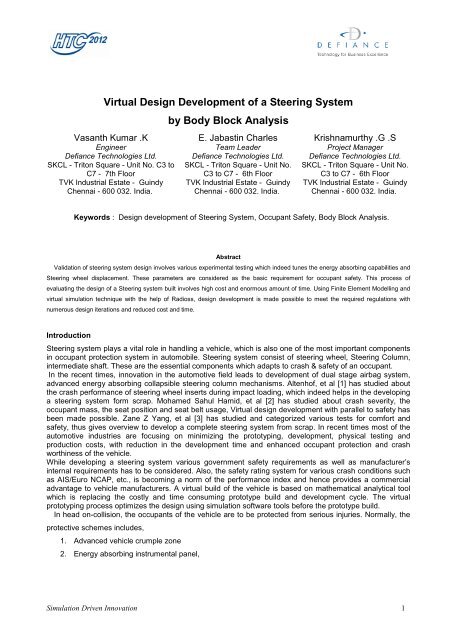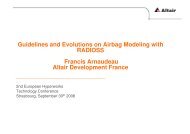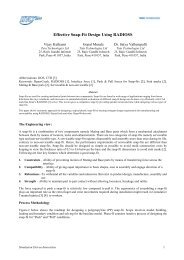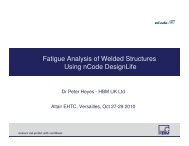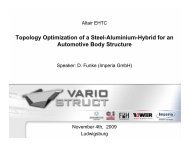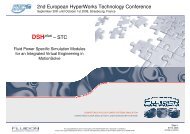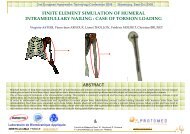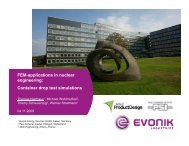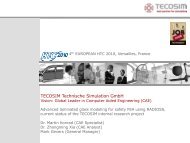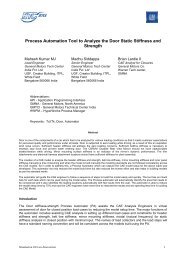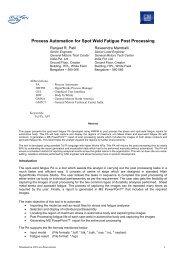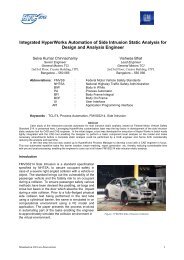Virtual Design Development of a Steering System by
Virtual Design Development of a Steering System by
Virtual Design Development of a Steering System by
You also want an ePaper? Increase the reach of your titles
YUMPU automatically turns print PDFs into web optimized ePapers that Google loves.
<strong>Virtual</strong> <strong>Design</strong> <strong>Development</strong> <strong>of</strong> a <strong>Steering</strong> <strong>System</strong><br />
Vasanth Kumar .K<br />
Engineer<br />
Defiance Technologies Ltd.<br />
SKCL - Triton Square - Unit No. C3 to<br />
C7 - 7th Floor<br />
TVK Industrial Estate - Guindy<br />
Chennai - 600 032. India.<br />
<strong>by</strong> Body Block Analysis<br />
E. Jabastin Charles<br />
Team Leader<br />
Defiance Technologies Ltd.<br />
SKCL - Triton Square - Unit No.<br />
C3 to C7 - 6th Floor<br />
TVK Industrial Estate - Guindy<br />
Chennai - 600 032. India.<br />
Krishnamurthy .G .S<br />
Project Manager<br />
Defiance Technologies Ltd.<br />
SKCL - Triton Square - Unit No.<br />
C3 to C7 - 6th Floor<br />
TVK Industrial Estate - Guindy<br />
Chennai - 600 032. India.<br />
Keywords : <strong>Design</strong> development <strong>of</strong> <strong>Steering</strong> <strong>System</strong>, Occupant Safety, Body Block Analysis.<br />
Abstract<br />
Validation <strong>of</strong> steering system design involves various experimental testing which indeed tunes the energy absorbing capabilities and<br />
<strong>Steering</strong> wheel displacement. These parameters are considered as the basic requirement for occupant safety. This process <strong>of</strong><br />
evaluating the design <strong>of</strong> a <strong>Steering</strong> system built involves high cost and enormous amount <strong>of</strong> time. Using Finite Element Modelling and<br />
virtual simulation technique with the help <strong>of</strong> Radioss, design development is made possible to meet the required regulations with<br />
numerous design iterations and reduced cost and time.<br />
Introduction<br />
<strong>Steering</strong> system plays a vital role in handling a vehicle, which is also one <strong>of</strong> the most important components<br />
in occupant protection system in automobile. <strong>Steering</strong> system consist <strong>of</strong> steering wheel, <strong>Steering</strong> Column,<br />
intermediate shaft. These are the essential components which adapts to crash & safety <strong>of</strong> an occupant.<br />
In the recent times, innovation in the automotive field leads to development <strong>of</strong> dual stage airbag system,<br />
advanced energy absorbing collapsible steering column mechanisms. Altenh<strong>of</strong>, et al [1] has studied about<br />
the crash performance <strong>of</strong> steering wheel inserts during impact loading, which indeed helps in the developing<br />
a steering system form scrap. Mohamed Sahul Hamid, et al [2] has studied about crash severity, the<br />
occupant mass, the seat position and seat belt usage, <strong>Virtual</strong> design development with parallel to safety has<br />
been made possible. Zane Z Yang, et al [3] has studied and categorized various tests for comfort and<br />
safety, thus gives overview to develop a complete steering system from scrap. In recent times most <strong>of</strong> the<br />
automotive industries are focusing on minimizing the prototyping, development, physical testing and<br />
production costs, with reduction in the development time and enhanced occupant protection and crash<br />
worthiness <strong>of</strong> the vehicle.<br />
While developing a steering system various government safety requirements as well as manufacturer’s<br />
internal requirements has to be considered. Also, the safety rating system for various crash conditions such<br />
as AIS/Euro NCAP, etc., is becoming a norm <strong>of</strong> the performance index and hence provides a commercial<br />
advantage to vehicle manufacturers. A virtual build <strong>of</strong> the vehicle is based on mathematical analytical tool<br />
which is replacing the costly and time consuming prototype build and development cycle. The virtual<br />
prototyping process optimizes the design using simulation s<strong>of</strong>tware tools before the prototype build.<br />
In head on-collision, the occupants <strong>of</strong> the vehicle are to be protected from serious injuries. Normally, the<br />
protective schemes includes,<br />
1. Advanced vehicle crumple zone<br />
2. Energy absorbing instrumental panel,<br />
Simulation Driven Innovation 1
3. An Energy absorbing <strong>Steering</strong> column and steering wheel<br />
4. A driver air bag<br />
5. An energy absorbing knee bolster.<br />
The current engineering specification for steering wheels lists about 15 different physical tests to which each<br />
<strong>Steering</strong> system must be validated. These tests, if performed physically, cost a lot o o<strong>of</strong><br />
money for a prototype<br />
wheel. Fortunately, many <strong>of</strong> the structural tests can be done virtually <strong>by</strong> numerical methods such as the<br />
finite element analysis.<br />
Recommendations based on analysis results have helped in cost savings <strong>by</strong> shortening product lead lead-time<br />
and reducing the number <strong>of</strong> prototype tests. This paper mainly focuses on <strong>Steering</strong> wheel, <strong>Steering</strong> column,<br />
and steering column mounting angle change through which the ma maximum ximum energy will be absorbed and also<br />
ensures the regulatory requirements. The designs <strong>of</strong> the individual components are based on specific<br />
vehicle architecture and the performance requirements which normally would vary widely. This paper will<br />
cover the process and methodology for understanding requirements, developing des designs to meet those<br />
requirements and virtual testing for validating those designs using Radioss. To build and analyze the model<br />
it requires both preprocessing and post processing tool. By using Radioss as the solver the there will be no<br />
need for expensive third party solvers solvers.<br />
Process Methodology<br />
The virtual tests for steering wheels can be categorized <strong>by</strong> nature into three types: modal analysis, static<br />
analysis, and impact analysis. This paper gives an overview <strong>of</strong> body block impact test using Radioss.<br />
Emphasis is placed on how to model the physical tests virtually under various conditions using finite element<br />
analysis. . Model setup is shown in Fig Fig.1, constraint and boundary conditions are shown. In addition,<br />
challenges and difficulties in the simulation process are addressed. In particular, various iterations carried<br />
out to develop a <strong>Steering</strong> system virtually are discussed.<br />
Simulation Driven Innovation<br />
Figure 11:<br />
Model Setup with boundary conditions<br />
OEMs are required to meet many mandatory government safety regulations in full vehicle system level.<br />
These regulations are stipulated under AIS/FMVSS standards <strong>by</strong> the he government and cover all types <strong>of</strong><br />
vehicle crashes such as head on on-collision, <strong>of</strong>fset frontal tal and side impact etc. in addition to government<br />
requirement, OEMs have their own compliance requirement to increase vehicle rating.<br />
Sub-system system level requirements are provided to verify the functioning <strong>of</strong> the components assembly. The<br />
component performance e requirement will widely vary depending upon the architecture <strong>of</strong> the full vehicle. In<br />
general, the individual component specifications may vary from one ne automotive manufacturer to other based<br />
on the vehicle architecture tecture which is shown in Fig Fig.2.<br />
2
In this paper, development <strong>of</strong> the <strong>Steering</strong> system is purely a CAE driven approach. As considering AIS<br />
096(head on-collision) and IS 11939: 1996(body block analysis) regulations as constraint. <strong>Steering</strong> system<br />
has been made to pass IS 11939:1996.<br />
When the steering control is struck <strong>by</strong> a body block released against this control at a relative speed <strong>of</strong> 24.1<br />
km/h (15mph),the force applied to the body block <strong>by</strong> the stee steering ring control shall not exceed 11111<br />
daN.<br />
When the steering control rol is struck <strong>by</strong> an impactor released against this control at a relative speed <strong>of</strong> 24.1<br />
km/h, the deceleration <strong>of</strong> the impactor shall not exceed 80 g cumulative for more than 3 milliseconds. The<br />
deceleration shall always be lower than 120 g with Channel Freq Frequency uency Class 600 Hz <strong>of</strong> ISO 6487 6487-1987.<br />
Body block impact analysis has been carried for numerous iterations such as<br />
1) Increasing collapsible length in the <strong>Steering</strong> column increases the energy absorbing capabilities as<br />
shown in Fig.3.<br />
Simulation Driven Innovation<br />
Figure.2: <strong>Virtual</strong> development architecture<br />
Figure 3: Collapsible stage in the <strong>Steering</strong> system<br />
3
2) Strengthening ng the intermediate shaft as shown in Fig.4 .4 will eventually transmits force obtained from<br />
the head-on on collision with concrete wall.<br />
3) Back ack collapse mechanism plays vital role in head-on on collision with concrete wall as per AIS 096<br />
regulation. Utilizing the maximum collapsible length will reduce the movement <strong>of</strong> <strong>Steering</strong> in vertical<br />
and horizontal direction thus will focus with the dummy.<br />
4) Altering <strong>Steering</strong> mounts with CCB which helps in holding <strong>Steering</strong> system such that when a force<br />
above 2 KN will disengages the front mounts from the CCB mounts.<br />
5) Altering the <strong>Steering</strong> angle with respect to universal join joints Fig.5. <strong>Steering</strong> system angle has been<br />
modified in such a way that wheel engagement with dummy is maximum.<br />
Simulation Driven Innovation<br />
Figure 4: Full <strong>Steering</strong> Assembly<br />
Figure 5: comparison <strong>of</strong> steering system from each iterations<br />
4
Results & Discussions<br />
Thus the final result obtained has maximum deceleration value 27g shown in Fig.9 and maximum reaction force<br />
between dummy and <strong>Steering</strong> system is about 9627 daN shown in Fig.8 with collapsible length <strong>of</strong> 67mm, Fig.6 and<br />
Fig.7 represents Lower first and second spring behavior with threshold limit <strong>of</strong> 2KN. So therefore the results obtained<br />
are well within the requirement.<br />
Benefits Summary<br />
Figure 6: Lower First collapsible stage Figure 7: Lower second collapsible stage<br />
Figure 8:Force on <strong>Steering</strong> Wheel Figure 9:Decceleration Pulse<br />
Benefits attained from this analysis are<br />
1. Reduces prototype costs, physical test setup for each iteration, design development cost <strong>by</strong> using<br />
Radioss solver.<br />
2. Minimizes overall cycle time to develop steering system from scarp.<br />
Future Plans<br />
Experimental Setup has to be done to validate the results obtained from virtual simulation.<br />
Conclusions<br />
<strong>System</strong> level design has been virtually analyzed and presence <strong>of</strong> any minor defects in the design has been<br />
found before physical prototype build. The system level design has to be validated to certain extent with<br />
experimental tests. A sub-system model based on body block was developed to evaluate the assembled<br />
column performance. Once the sub-system model has been correlated, many design changes were<br />
evaluated without actual build and this reduced the development time.<br />
Simulation Driven Innovation 5
In conclusion, the virtual prototyping using computational and numerical approach helped to develop and<br />
evaluate a driver protection module in much lesser cost and time. Also, the Radioss provided tools for<br />
impact analysis which indeed reduces time and cost <strong>of</strong> performing this analysis.<br />
ACKNOWLEDGEMENTS<br />
Authors wish to thank management <strong>of</strong> Defiance Technologies Limited for permitting to publish this material.<br />
REFERENCES<br />
1) W. Altenh<strong>of</strong>, B. Arnold, Z. Li, O. Nabeta and R.Turchi, A Comparison <strong>of</strong> the Crash Performance <strong>of</strong> Three-spoke and Four-spoke<br />
<strong>Steering</strong> Wheel Armatures during Impact Loading, Int. J. Vehicle <strong>Design</strong>, Vol. 35 (2004), No. 3, pp. 186-209.<br />
2) Mohamed Sahul Hamid, Nirmal Narayanasamy and Minoo J.Shah, "<strong>System</strong> Approach in development <strong>of</strong> adaptive energy absorbing<br />
steering <strong>by</strong> virtual engineering ", SAE paper # 2005-01-0705 SAE 2005 World Congress , Detroit, MI, April 11-14,2005.<br />
3) Zane Z Yang, Srini V, Raman and Deren Ma, "<strong>Virtual</strong> Tests for Facilitating <strong>Steering</strong> Wheel <strong>Development</strong>", SAE paper # 2005-01-<br />
1072 SAE 2005 World congress, Detroit, MI, April 11-14,2005.<br />
4) FTSS Free Motion Headform Model, Version 3.2, First Technology Safety <strong>System</strong>,2000.<br />
5) ECE-R12- Impact Against <strong>Steering</strong> Mechanism, 1999.<br />
6) FMVSS 203 - Impact Protection for the driver from <strong>Steering</strong> control <strong>System</strong>, 2003.<br />
7) HyperMesh 11.0(Radioss) User Manual, Altair Engineering.<br />
Simulation Driven Innovation 6


